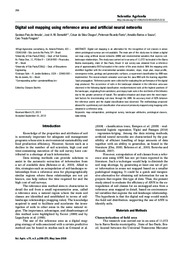Digital soil mapping using reference area and artificial neural networks.
Digital soil mapping using reference area and artificial neural networks.
Author(s): ARRUDA, G. P. de; DEMATTÊ, J. A. M.; CHAGAS, C. da S.; FIORIO, P. R.; SOUZA, A. B. e.
Summary: Digital soil mapping is an alternative for the recognition of soil classes in areas where pedological surveys are not available. The main aim of this study was to obtain a digital soil map using artificial neural networks (ANN) and environmental variables that express soillandscape relationships. This study was carried out in an area of 11,072 ha located in the Barra Bonita municipality, state of São Paulo, Brazil. A soil survey was obtained from a reference area of approximately 500 ha located in the center of the area studied. With the mapping units identified together with the environmental variables elevation, slope, slope plan, slope profile, convergence index, geology and geomorphic surfaces, a supervised classification by ANN was implemented. The neural network simulator used was the Java NNS with the learning algorithm "back propagation." Reference points were collected for evaluating the performance of the digital map produced. The occurrence of soils in the landscape obtained in the reference area was observed in the following digital classification: medium-textured soils at the highest positions of the landscape, originating from sandstone, and clayey loam soils in the end thirds of the hillsides due to the greater presence of basalt. The variables elevation and slope were the most important factors for discriminating soil class through the ANN. An accuracy level of 82% between the reference points and the digital classification was observed. The methodology proposed allowed for a preliminary soil classification of an area not previously mapped using mapping units obtained in a reference area
Publication year: 2016
Types of publication: Journal article
Unit: Embrapa Soils
Observation
Some of Embrapa's publications are published as ePub files. To read them, use or download one of the following free software options to your computer or mobile device. Android: Google Play Books; IOS: iBooks; Windows and Linux: Calibre.
Access other publications
Access the Agricultural Research Database (BDPA) to consult Embrapa's full library collection and records.
Visit Embrapa Bookstore to purchase books and other publications sold by Embrapa.

